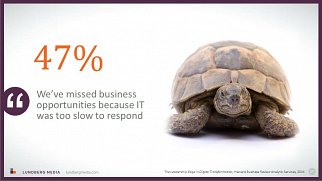Blog Post

The chief digital officer was the third most in-demand C-level position this year, according to executive search firm Korn Ferry. The rise of the chief digital officer (CDO) reflects the disruption being felt across industries from digital transformation and the impact this is having on organizations' business models. Well over half of respondents to a recent survey by Harvard Business Review Analytic Services say their organization's business model will be radically different in three years. These changes don't just happen; they need to be led.
Blog Post

I have to admit it — I'm baffled. In all the research I've done in the past year, business leaders again and again say they believe the CIO is the right person to lead digital innovation. And yet, again and again, there's a gap between where everyone — CIOs and their business partners included — think the CIO should be and where they actually are. CIOs just can't seem to break out of the technology service provider role.
In the Harvard Business Review Analytic Services study, "Business Transformation and the CIO Role," 94% of respondents said CIOs would add the most value to the business by either leading business technology transformation or, even better, leading IT-driven business innovation and strategy. Only 6% voted for the CIO to focus on running the IT function to support business operations. And yet the vast majority — 70% — said that's exactly where the CIO spends his or her time.
I've also had a number of conversations lately with strategic CIOs who view their role as helping their business leverage information — they frame the digital opportunity in that context. Sure, they need technology to do that, but that's not where the value lies or how they define their role.
Blog Post

Back in the 1990s and into the early part of the 2000s, we ran an awards program at CIO magazine called the Enterprise Value Awards. This was a unique and truly outstanding awards program that scrutinized the work being done by CIOs and their business partners — and the results being delivered — through the use of information technology. Every nomination had to have a CIO and a business leader as joint sponsors. They had to prove claimed financial value by having the company's CFO sign off on the numbers. Every finalist received a site visit from an experienced reviewer who met in person with company leaders and users of the system to vet the claims being made. These review board members then presented their findings to a blue-ribbon panel of CIOs at a day-long meeting in Boston. The winners were recognized at an annual Enterprise Value Retreat.
Blog Post

I just had my first highlights reel made and I'm pretty excited. I delivered the opening keynote at the Oracle Cloud World conference in Boston in December 2014. Oracle did a great job filming it in the first place, and my friend the very talented videographer Craig Kimberley at Skyprop Media did a great job editing it down to a couple of minutes. This shows both my onstage work and the kinds of (very visual) slides that I create. I hope you like it!
Blog Post

Creating the conditions for and harnessing innovation isn't easy, especially for large organizations. Innovation Accelerators — companies that are committed to innovation across the enterprise — take a managed, structured approach. That may seem contradictory — after all, isn't innovation supposed to be creative and spontaneous? Creative, yes, but if you rely on spontaneous combustion to light your innovation process, your results will be uneven at best.





